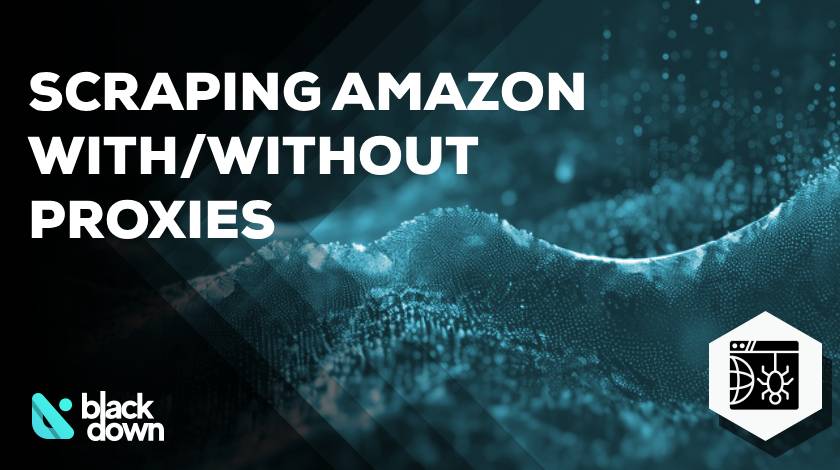If you’ve ever tried to collect product data from Amazon at scale, you’ve probably hit a wall quickly. Amazon’s anti-scraping defenses are aggressive, but that doesn’t mean scraping is impossible. The real question is whether you should use proxies or try to work without them.
In my experience with data extraction projects, I’ve seen both approaches succeed and fail. Let me walk you through proxy-based versus non-proxy scraping methods, the challenges you’ll face, and what tools you need to build a working scraper.
Understanding Amazon’s Anti-Scraping Defenses
Amazon has built multiple defense layers that work together to identify and block automated traffic.
First, IP tracking monitors how many requests come from a single IP and how quickly. Too many requests too fast results in blocks or CAPTCHA challenges.
Second, request fingerprinting analyzes your HTTP headers. Real browsers send specific headers like User-Agent and Accept-Language. If your scraper sends bare-bones or identical requests, Amazon spots the pattern.
Third, behavioral analysis tracks user actions. Real users scroll, click, and pause randomly. Bots loading dozens of pages without interaction stand out immediately.
You need an approach that addresses all three layers.
Scraping Amazon With Proxies
Using proxies is the standard approach for serious Amazon scraping. A proxy acts as an intermediary between your scraper and Amazon’s servers, masking your real IP address and making your traffic appear to come from different locations.
Types of Proxies and Their Effectiveness
There are three main proxy types with different strengths and weaknesses.
Datacenter proxies are cheapest and fastest but easiest for Amazon to detect and block. Amazon knows data center IP ranges, and blocking one often blacklists the entire subnet. I don’t recommend these unless you’re doing very light scraping.
Residential proxies are IP addresses from real consumer connections. They look like legitimate home users and are much harder to detect. This is the sweet spot for most Amazon scraping projects, and services like Decodo specifically recommend residential proxies as the best balance between cost and effectiveness for Amazon. They cost more but offer better reliability and lower block rates.
Mobile proxies use cellular network IPs and offer the highest anonymity. They’re extremely difficult to distinguish from real mobile users but are significantly more expensive, typically reserved for when other methods fail.
How Rotating Proxies Work
Rotation is where proxies shine. Instead of sending all requests through a single proxy, you cycle through a large pool of IPs. This keeps the per-IP request rate low and makes your traffic look like many different users. Amazon’s rate limiting becomes ineffective because no single IP triggers alarms.
Advantages and Disadvantages
The biggest advantage is scale. With proxies, you can make thousands of requests without blocks, scraping entire product categories or monitoring competitor pricing across regions. You also get access to geo-restricted content and automatic failover if one IP gets blocked.
The main downside is cost. Good residential proxies aren’t cheap at high volume. You pay per gigabyte or per IP, and costs add up. There’s also complexity in integrating rotation and handling proxy failures.
Scraping Amazon Without Proxies
Can you scrape Amazon without proxies? Technically yes, but your options are extremely limited.
Direct Scraping Attempts
If you try scraping from a single IP, you’ll hit rate limits within minutes. Some people add long delays between requests, but this only works for tiny projects needing a few dozen data points. Meaningful data collection becomes nearly impossible.
Using Amazon’s Official API
Amazon’s Product Advertising API provides structured product data legally. The data is reliable and you’re not violating terms. However, you need affiliate program approval, face strict rate limits, and only access certain data points. This works for small-scale needs but lacks flexibility for large-scale collection.
Third-Party Data Services
Services like Keepa or CamelCamelCamel aggregate Amazon data through APIs or dashboards. You don’t do any scraping, so there’s zero risk of being blocked.
The trade-off is flexibility. You’re limited to their data. If you need custom data points or products outside their database, you’re out of luck. Subscription fees also apply.
When Non-Proxy Methods Make Sense
Non-proxy approaches work for small, specific data needs. Monitoring a handful of products? Use the official API or third-party services. Academic research with small datasets? Direct scraping with long delays might work. But for competitive intelligence, market research, or large-scale collection, you’ll need proxies.
Key Challenges You’ll Face
Certain challenges are universal when scraping Amazon:
- IP Bans and Rate Limiting: Amazon blocks suspicious traffic patterns. Too many requests too quickly results in bans. With proxies, you distribute requests across many IPs. Without them, you’re extremely vulnerable. Use rotating residential proxies with randomized patterns and realistic delays.
- CAPTCHA Challenges: Amazon presents CAPTCHAs when suspecting bot activity. Good proxies and human-like behavior reduce these, but integrate a CAPTCHA-solving service like 2Captcha or Anti-Captcha for when they appear.
- Request Fingerprinting: Amazon analyzes HTTP headers, browser fingerprints, and request patterns. Make your scraper imitate real browser traffic with realistic User-Agent strings and standard headers. Headless browsers like Selenium or Playwright automate this.
- Geographic Restrictions: Amazon’s content varies by region. Proxies from specific locations let you see what users in those areas see.
- Legal and Ethical Considerations: Amazon’s Terms of Service prohibit unauthorized scraping. They can ban accounts, blacklist IPs, or pursue legal action. Proceed carefully. Respect rate limits, don’t overload servers, and use official APIs or third-party sources when possible.
Making Your Decision
Should you use proxies? For anything beyond trivial scraping, the answer is almost always yes. Proxies give you the scale, reliability, and geographic flexibility to collect meaningful data from Amazon.
Non-proxy methods work for specific use cases: small datasets, official API access, or third-party aggregated data. But for competitive intelligence, market research, or substantial data collection, you’ll need rotating residential proxies. The investment pays for itself through collected data and time saved fighting IP bans.
Final Thoughts
Scraping Amazon is challenging but far from impossible. The key is understanding the defenses and choosing the right approach. Proxies aren’t optional for serious projects. They’re the foundation.
If you’re getting started, begin with a small project using Python, Requests, Beautiful Soup, and a residential proxy service. As you gain experience, scale up to Scrapy and CAPTCHA solving.
Remember the technical challenges are only part of the picture. Always consider the ethical and legal implications. Respect Amazon’s infrastructure, stay within reasonable limits, and look for official alternatives when available. With the right tools and approach, you can collect what you need while staying under the radar.
Kevin Ngure
Related posts
Popular Articles
Best Linux Distros for Developers and Programmers as of 2025
Linux might not be the preferred operating system of most regular users, but it’s definitely the go-to choice for the majority of developers and programmers. While other operating systems can also get the job done pretty well, Linux is a more specialized OS that was…
How to Install Pip on Ubuntu Linux
If you are a fan of using Python programming language, you can make your life easier by using Python Pip. It is a package management utility that allows you to install and manage Python software packages easily. Ubuntu doesn’t come with pre-installed Pip, but here…











